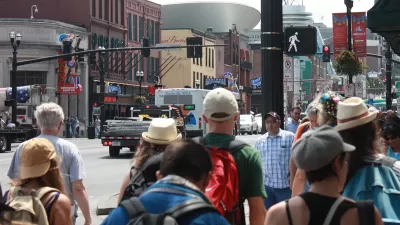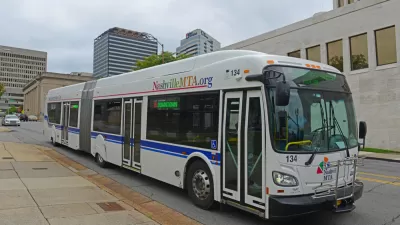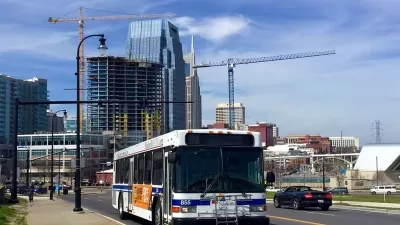Nashville Mayor Megan Barry resigned from office earlier this month. The question now becomes whether an ambitious transit investment plan she supported can survive her exit.

As Nashville Mayor Megan Barry's fall from grace continues, it raises the question: how will the scandal affect the legacy of her priorities during her abbreviated time in office? Namely, her transit plan. Barry’s transit plan—the construction of a light rail system to the tune of $9 billion over 15 years—has created friction in the city over how to move forward. If Nashville handles transit well, it could be a lesson to the entire southeast on how to move people in an increasingly populated region.
Opponents of the transit plan balk at the price tag and tax hikes, and now have added ammunition from Barry's misuse of funds during her tenure in office. Meanwhile, supporters champion a light rail proposal that could make their city more progressive by providing more service to a larger area, improving ease of travel for poorer residents.
Each side claims its plan will be the one to reduce congestion in Nashville’s center, a growing issue in the city as it attempts to stay competitive with its regional rivals. Currently, Nashville ranks 19th in the country for congestion. In the southeast, it's second only to Atlanta.
Unfortunately, solving these issues is not as easy as saying "trains good, cars bad." Likewise, adding road space will do nothing but exasperate Nashville’s congestion problem. Critics of the plan, like Randal O’Toole of the Cato Institute, have offered "more lanes of traffic on highways" as the alternative to the light rail plan.
What critics fail to see is that increased road space is detrimental to the long-term health of the city and fails to solve the original congestion problem.
Consider the problem of induced demand. It demonstrates that expanding a roadway does not ease traffic, but rather creates more demand for passengers on that road, creating additional congestion. Data suggests decreasing road space along certain routes is a better solution for decreasing congestion. It seems counter-intuitive, but study after study shows that more lanes mean more traffic.
Drivers often take roads for granted because we don’t see the actual cost of building and maintaining them, but road infrastructure is incredibly expensive. Governor Bill Haslam’s gas tax increase was a priority last year so that Tennessee could put a dent in its over $6 billion in DOT backlogs.
Further west, Los Angeles recently invested $1.4 billion in its freeway system, to little effect––the city continues to have some of the worst congestion in the country.
Despite claims made by O’Toole, public transit is still safer than auto travel, and the figures aren’t even close. Light rail is 20 times safer than car travel, and bus travel is 30 times safer.
The city will face economic shockwaves if roads are deemed the solution to its congestion problems. Strong Towns, an organization dedicated to the fiscal health of cities, has noted several problems with auto-oriented development. In addition to how expensive it is, creating roads also eats into land that could otherwise generate tax revenue for the city.
Other problems with prioritizing the automobile include greater social isolation, rising obesity rates due to walking less, and increased carbon emissions.
Nashville’s mass transit plan actually solves a good number of these problems. Public transit encourages walkability, which fights obesity, creates an environment conducive to economic growth, is inclusive to those who have disabilities or cannot afford a vehicle, and tends to lead to happier, healthier lives.
Economist Joe Cortright found that an increase in walkability corresponded with increasing home values. Cortright found an average increase of $3,000 per point on Walk Score, a metric for the ease at which someone can complete daily errands on foot. The opposite is true of car-oriented development. In his 2012 book Walkable Cities, urban planner Jeff Speck notes an inverse correlation with property values and nearby freeway construction.
That isn’t to say Nashville’s plan has everything right. Cities tend to have a "build it and they will come" mentality when considering transit options. Public transit has its share of failures. Dallas, for example, spent hundreds of millions on the largest light rail system in the U.S., and currently sees higher automobile transit rates than ever before.
Transit's critics are also not wrong to be concerned about spending with a $9 billion bill, but they should take note that cities must invest in transit that fits the needs—and the size—of their city. After all, transit plans should grow incrementally along with the city.
An incremental plan also alleviates large initial costs and financial burdens on the city and taxpayers. Spacing bus improvements, bike infrastructure, and rail lines out as the city can afford them reduces debt payments, allows the city to experiment with what works, and allows the culture to shift from one mode of transportation to another.
Nashville can attempt to solve its problems by making way for the automobile, or it can turn to an investment in public transit, which will provide a path to freedom from car dependence and a stronger city in the long run.
Ethan A. Greene is a graduate of Public Policy at the University of Tennessee at Chattanooga and a Master’s Student for City and Regional Planning. His writing on urban issues has appeared in Spiked, Real Clear Policy, and Nooga.com.

Maui's Vacation Rental Debate Turns Ugly
Verbal attacks, misinformation campaigns and fistfights plague a high-stakes debate to convert thousands of vacation rentals into long-term housing.

Planetizen Federal Action Tracker
A weekly monitor of how Trump’s orders and actions are impacting planners and planning in America.

In Urban Planning, AI Prompting Could be the New Design Thinking
Creativity has long been key to great urban design. What if we see AI as our new creative partner?

California Creates Housing-Focused Agency
Previously, the state’s housing and homelessness programs fell under a grabbag department that also regulates the alcohol industry, car mechanics, and horse racing.

Chicago’s Ghost Rails
Just beneath the surface of the modern city lie the remnants of its expansive early 20th-century streetcar system.

Baker Creek Pavilion: Blending Nature and Architecture in Knoxville
Knoxville’s urban wilderness planning initiative unveils the "Baker Creek Pavilion" to increase the city's access to green spaces.
Urban Design for Planners 1: Software Tools
This six-course series explores essential urban design concepts using open source software and equips planners with the tools they need to participate fully in the urban design process.
Planning for Universal Design
Learn the tools for implementing Universal Design in planning regulations.
planning NEXT
Appalachian Highlands Housing Partners
Mpact (founded as Rail~Volution)
City of Camden Redevelopment Agency
City of Astoria
City of Portland
City of Laramie





























